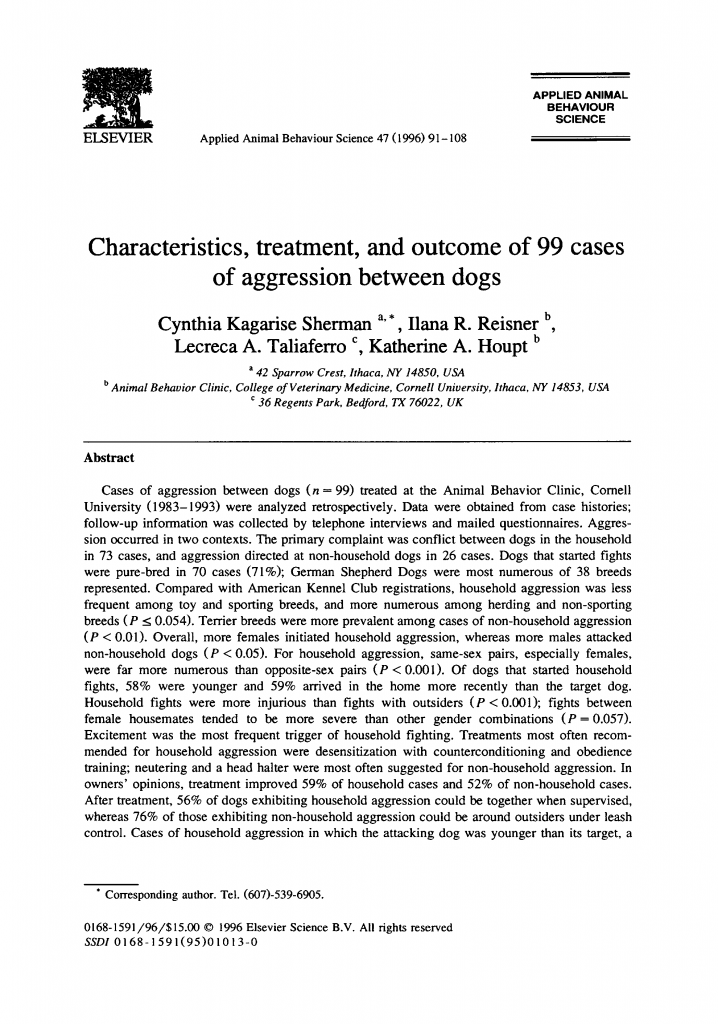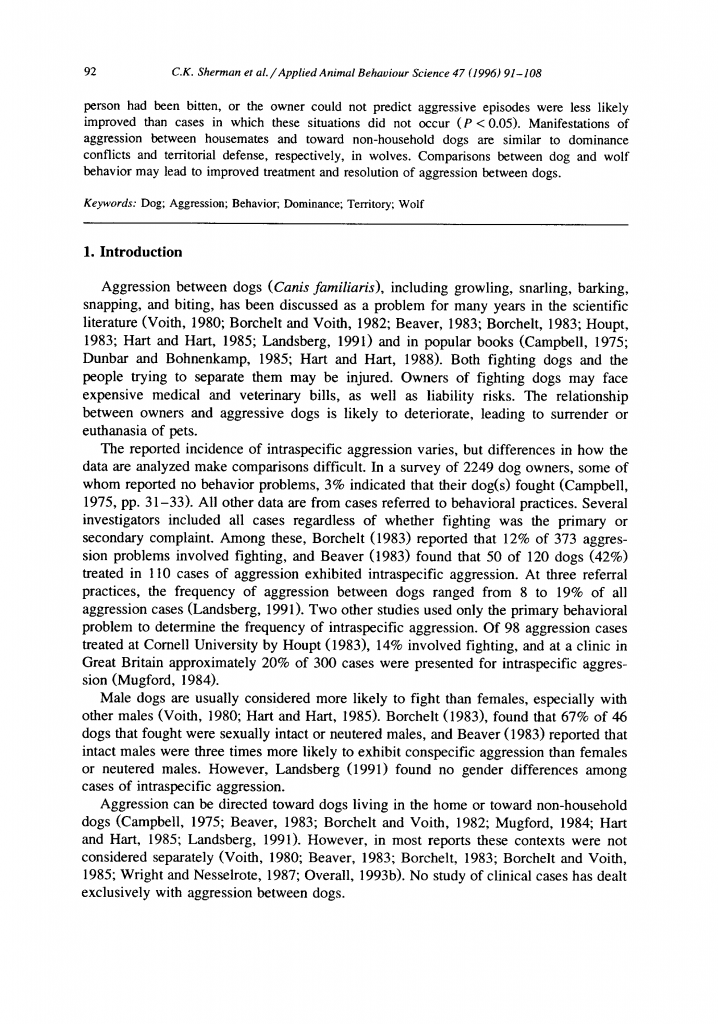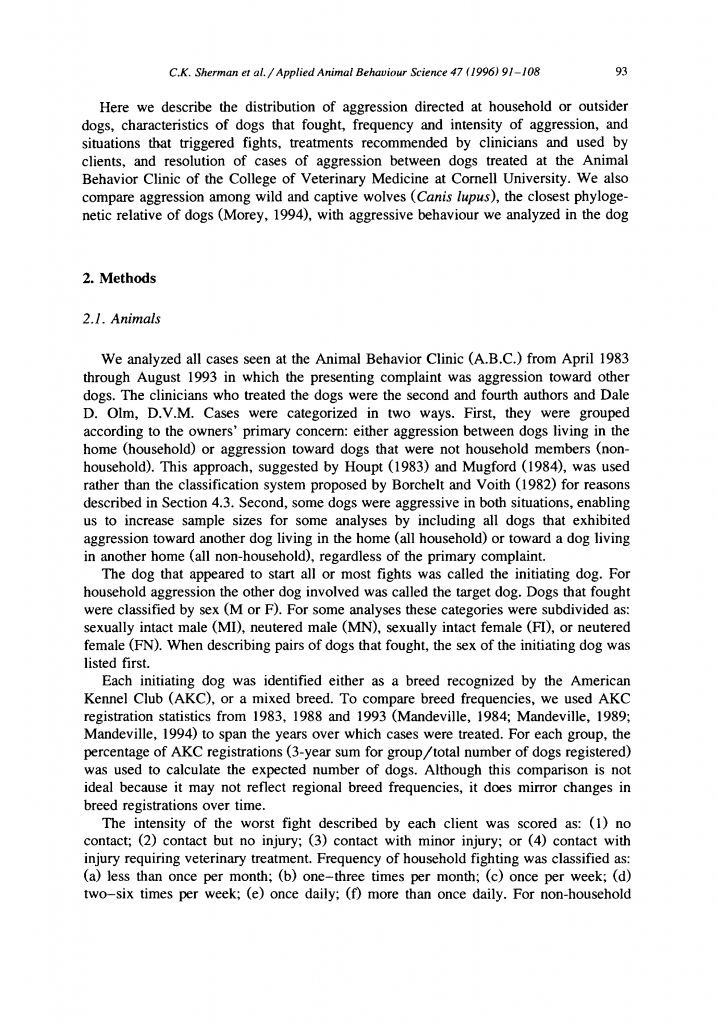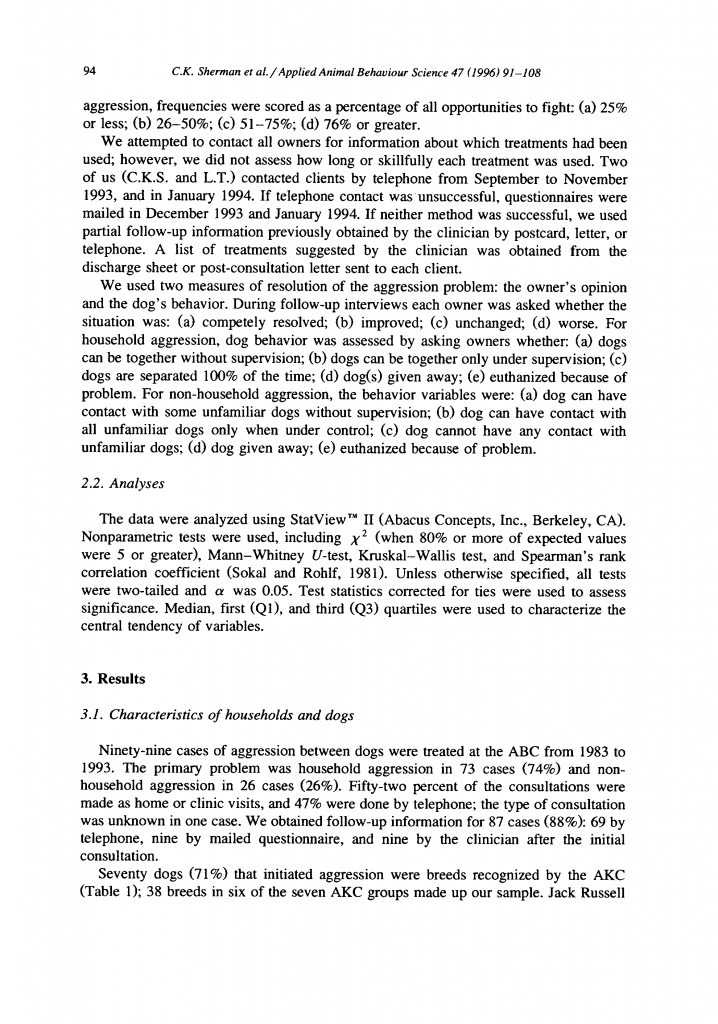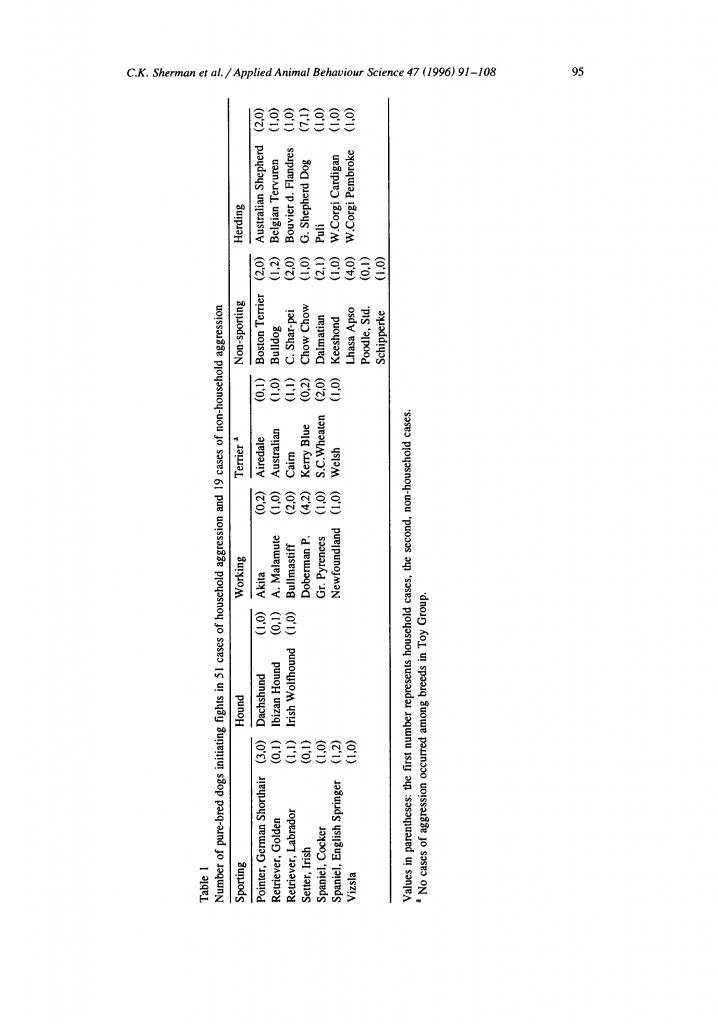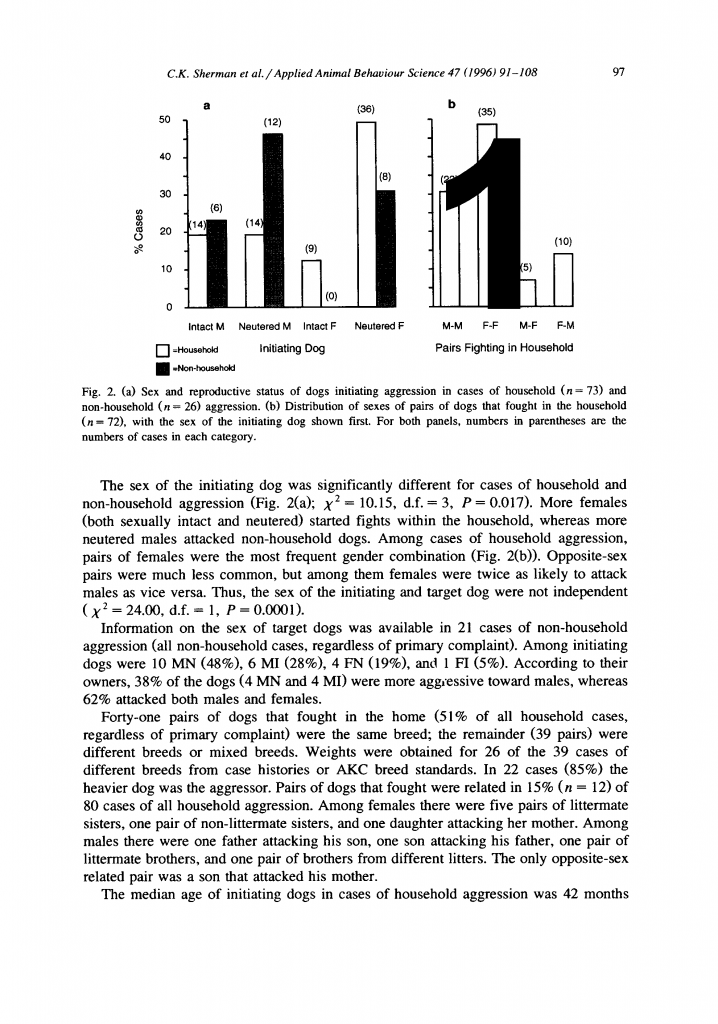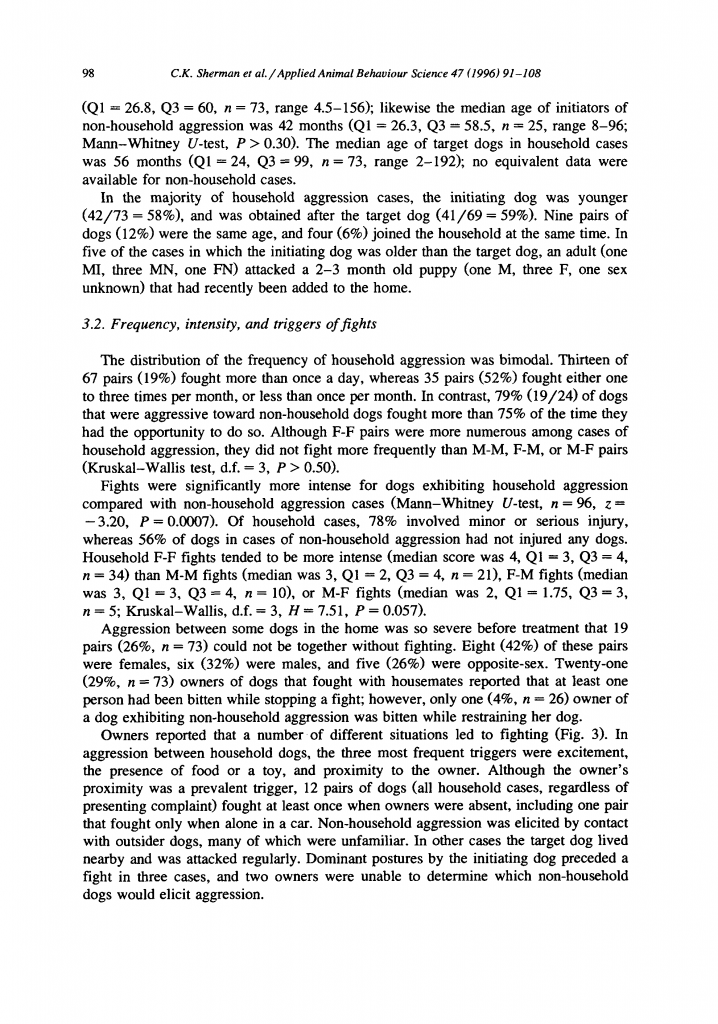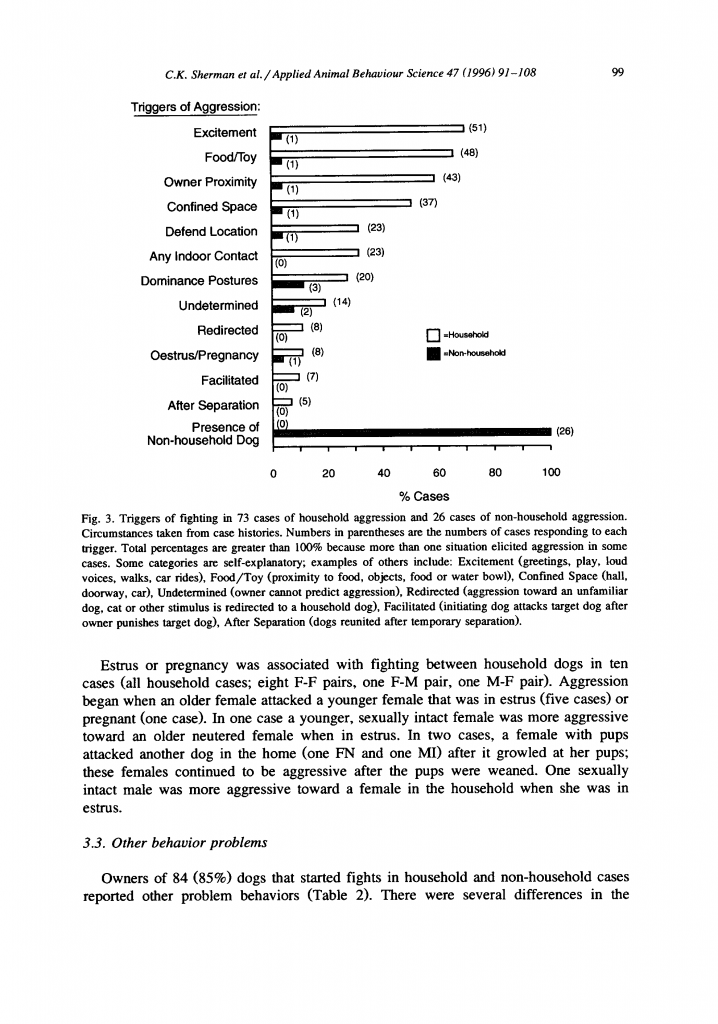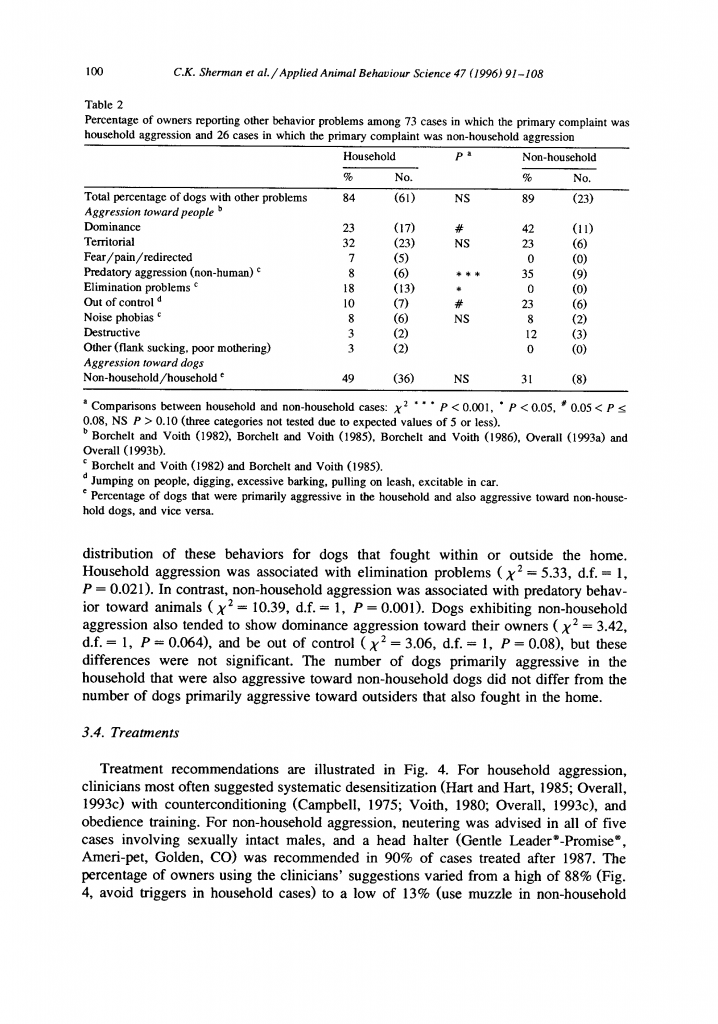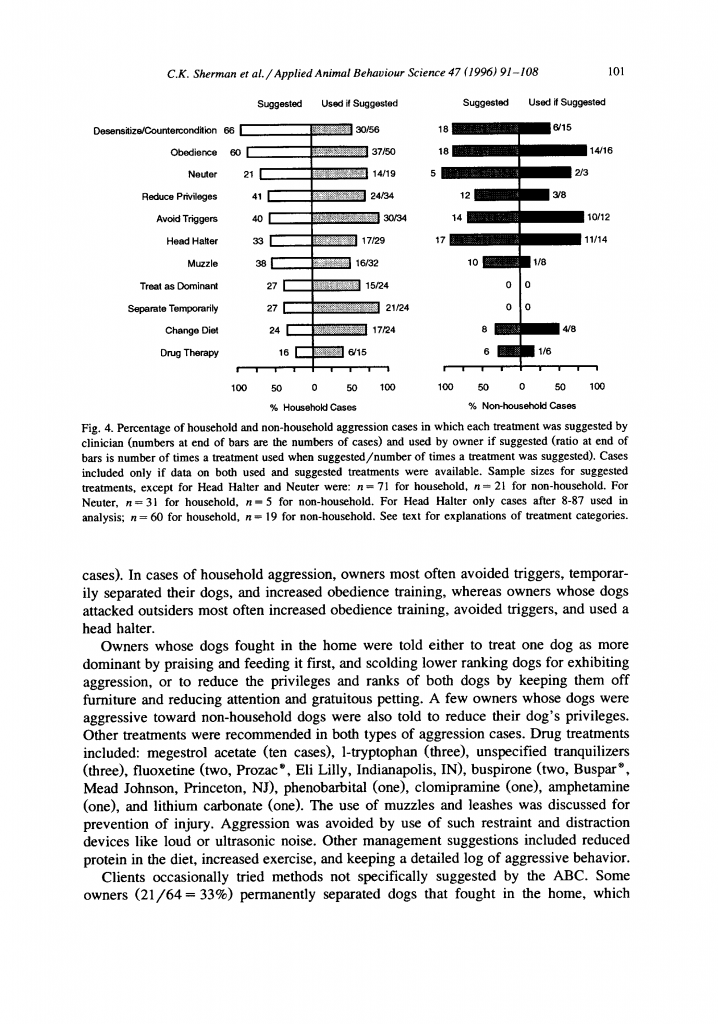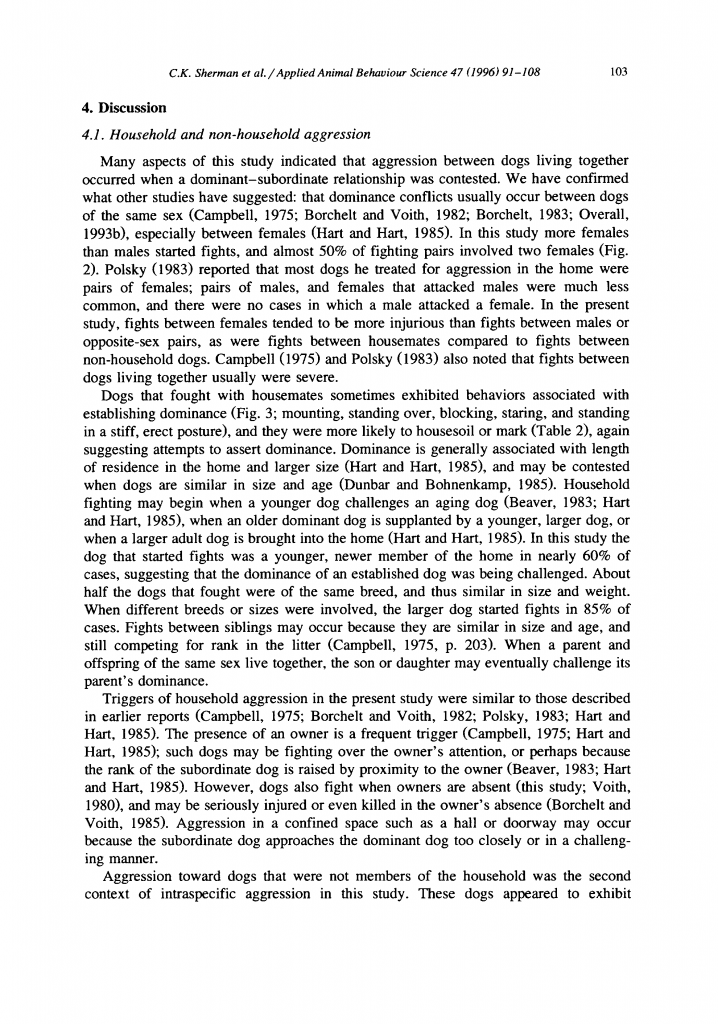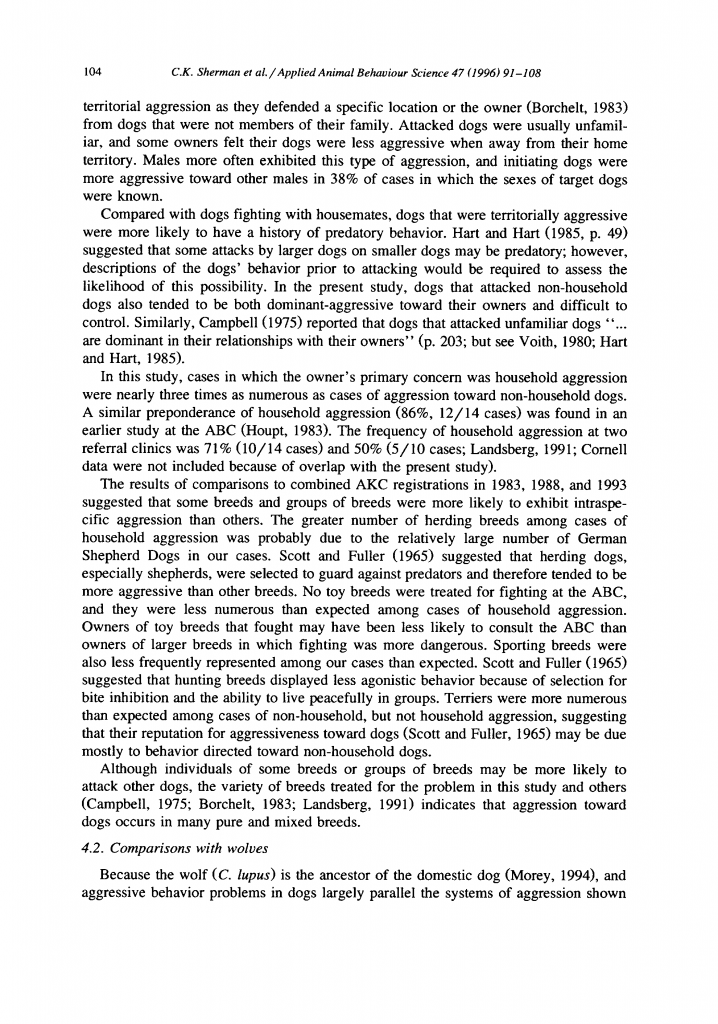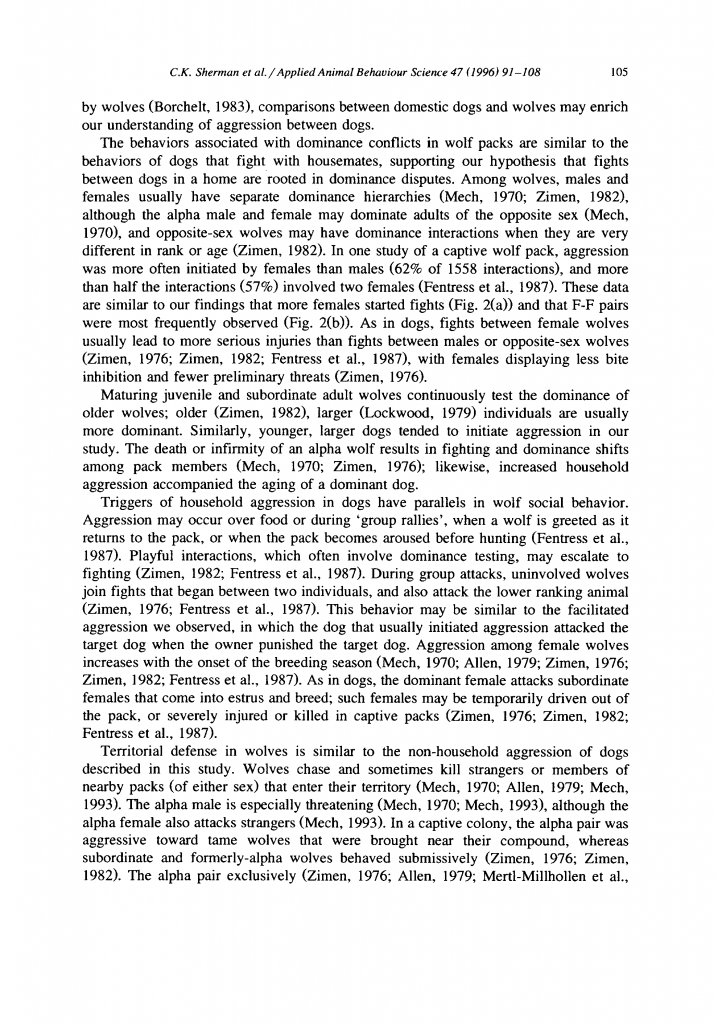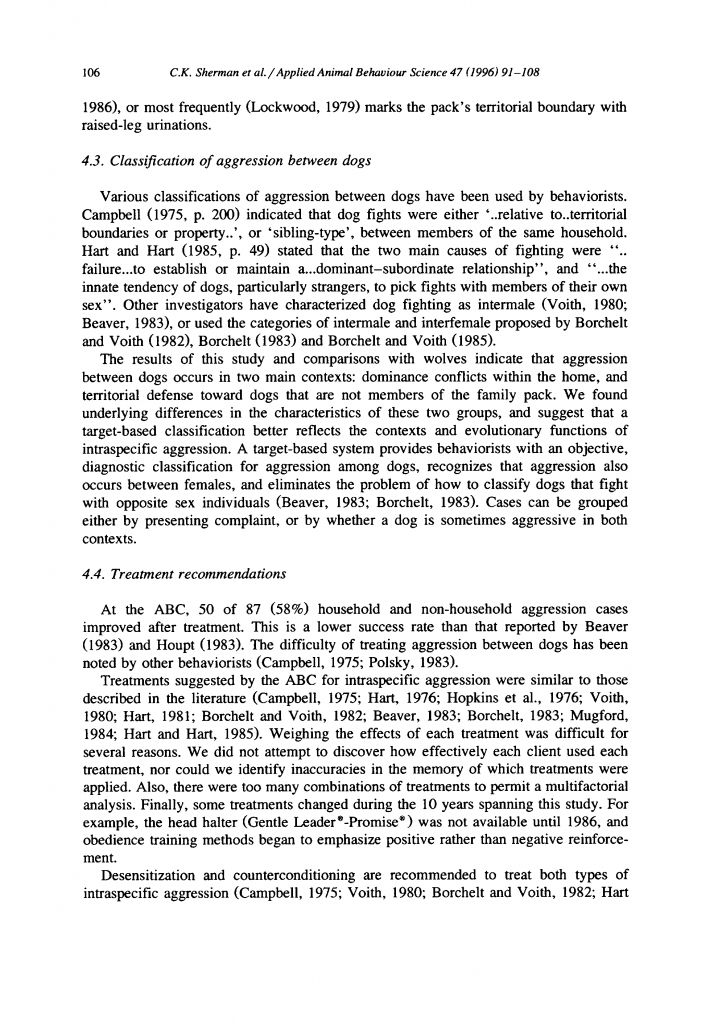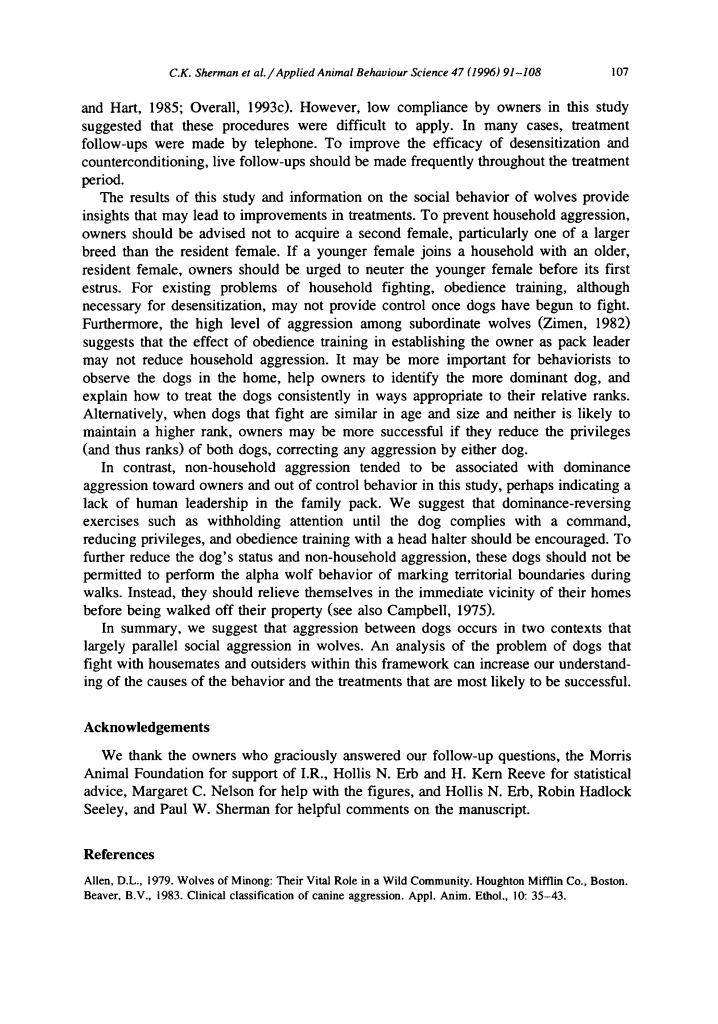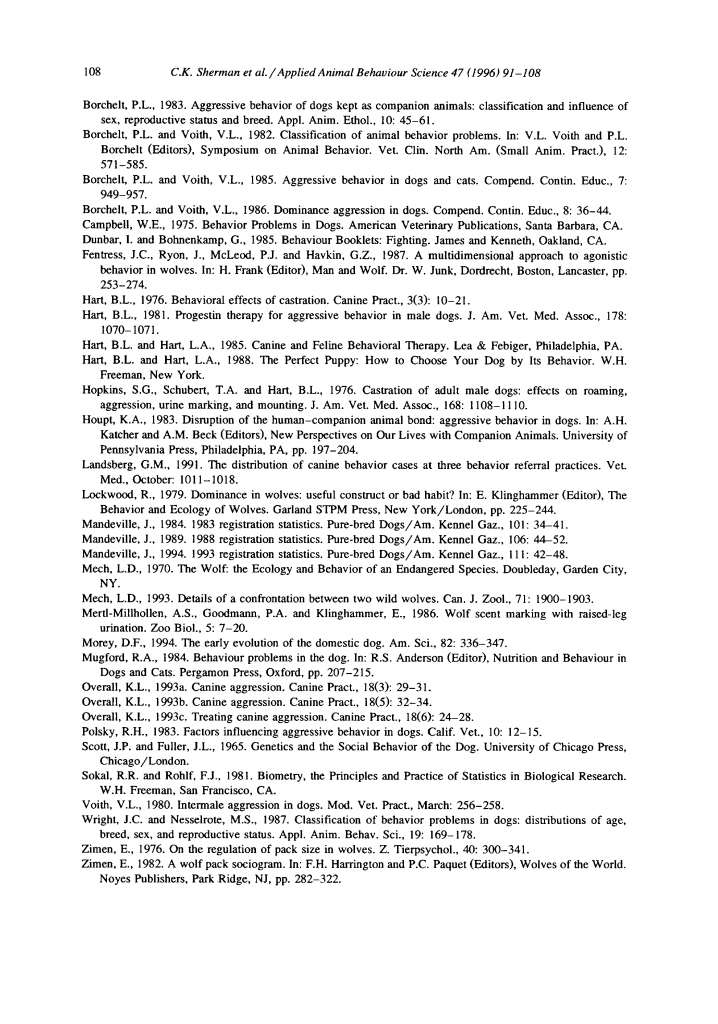Websites/Links:
Behavior
- 1. How Animals Learn
- 2. Rewards/Reinforcement
- 3. Fear Aggression
- 4. Interdog Aggression
- 5. The ``Look`` Cue
- 6. Calming/Redirection Exercises
- Gender Agression Study
How Animals Learn
Changing a pet’s undesirable behaviors to acceptable ones requires that you understand how a pet learns. Pets learn on their own all the time-a dog who jumps on the counter and finds there the leftovers from lunch, learns that jumping on the counter has a big payoff. The motivation for this learning comes from the pet himself. When you try to teach your pet new behaviors, the motivation comes from you. The behaviors that you want are not necessarily those that your pet wants. Understanding the process of learning will make you more effective at teaching the behaviors you find desirable.
Learning is shaped by the consequences of actions. Reinforcement, sometimes called reward, increases the probability that a given behavior will be repeated. It is a promise that something good will follow the behavior. Consistent reinforcement can increase both the frequency and the intensity of the repetition. Positive reinforcement is the addition of something pleasant immediately after a behavior; for example, a dog sits, and immediately receives a food treat. Negative reinforcement is the removal of something unpleasant immediately after the behavior; for example, a rider squeezes her legs against a horse’s side, the horse begins walking, and the squeezing stops. Punishment decreases the probability that a behavior will be repeated. It is a threat that something bad will follow the behavior. Positive punishment is the addition of something unpleasant after a behavior; for example, a dog barks, and a citronella collar sprays his face. Negative punishment is the removal of something pleasant after a behavior; for example, a dog
jumps up and a person turns away and ignores him.
Punishment is generally a less effective learning aid than reinforcement, particularly with pets who have behavior problems. The biggest drawback to punishment is that it aims at stopping an undesirable behavior, rather than teaching and encouraging a desirable one. “No!” may stop your pet from doing something he should not, but it does not provide any guidance about what the pet should do. Punishment tends to increase fear and anxiety, both of which interfere with the ability to learn, and increase the risk that the pet will
react with aggression.
Reinforcement is used to distinguish desirable behaviors from unacceptable ones. It is both a marker for the behaviors you want and a motivator for your pet to repeat them. Reinforcement is most effective when you chose rewards from your pet’s point of view, using those he seems to value. A more valued reward will have a greater impact, so high quality rewards should be used to reinforce very desirable behaviors. Timing is essential: you need to reinforce the behavior immediately, or even as it is occurring. For this
reason, an intangible reinforcer, like praise, is always coupled with a tangible reward, like
food or a toy. Any time you introduce a new behavior, you need to use both for each repetition until the pet produces that behavior reliably whenever you request it. Even after the behavior seems solid, you are wise to use a tangible reward occasionally, so that the pet anticipates that any repetition may result in a reward. The intangible reinforcer, like praise, should always be used, no matter how well the behavior has been learned.
We ask you to reinforce desirable behaviors and ignore undesirable ones, rather than correct them. Correction, which is another term for positive punishment, is counterproductive in behavior modification, which is essentially learning. If a dog sits when requested, and receives a treat, the word “sit” becomes a promise that something good will follow the behavior it requests. If a dog does not sit when requested, and receives a leash jerk, the word “sit” becomes a threat that something bad will follow the lack of the behavior it requests. The signal that the dogs acts on, “sit”, is now both promise and threat. The anxiety provoked by the anticipation that the word “sit” can lead to two different results, can make training an average dog difficult. For a dog with a behavior problem, a dual approach using both reinforcement and punishment may make behavior modification impossible, and even harm his relationship with you.
Learning new and desirable behaviors can be difficult for pets with behavior problems. This is because fear and anxiety cause the pets to view ordinary situations as emergencies. A pet with separation anxiety may panic when you leave, and be unable to calm himself. A pet with fear of social situations may try to flee or attack, and be unable to pay attention to you when unfamiliar people or animals approach. This is why we begin with basic behavior modification exercises that you do with the pet in a quiet, safe place. The pet cannot learn new behaviors in difficult situations until he can pay
attention to you in nonthreatening settings. Remember that a stimulus that provokes a reaction from your pet will not desensitize him to something upsetting. Placing him repeatedly in situations that provoke a reaction will actually sensitize him to such situations and make the problem worse in spite of your time and effort. If your pet reacts to a stimulus and cannot pay attention to you, he should be removed from that setting promptly. You will maximize the results of your efforts if you are content with small steps and slow progress. Your pet will have good days and bad days, and you can
become more effective by observing what contributes to a good day or a bad one. A mistake is an opportunity for you to learn more about the specifics of your pet’s problem, and to develop management strategies. The most reasonable approach is not to expect perfection, but to expect and work toward a better quality of life for pets and the people who care for them.
Rewards/Reinforcement
A reward is a consequence of a behavior that is meant to increase the likelihood that the behavior will be repeated. It always comes after the behavior, not before. It may be helpful to use the
term reinforcer for reward, since it describes exactly why we use rewards.
For a reward or reinforcer to be effective, the timing, intensity and consistency are crucial. Problems will arise if any of these elements is not appropriate. You are trying to use the reinforcer to greatest advantage to teach your pet behaviors that you WANT. This often involves teaching the pet to substitute a desirable behavior for a problem one. Although objections are sometimes raised about having to reinforce a pet for something it “should” do, this is nothing more than making use of what is known about the learning process-an action that has a positive or beneficial result is much more likely to be repeated than one that has a neutral or a negative result. Pets who come to the behavior service have anxieties or fears that have led to difficulties in social situations with people or other animals, or problems adjusting to the human
environment in which they are living. They are already at risk, and managing them demands
strategies that are recognized as effective in changing behavior. Properly used reinforcers are the most reliable way to improve the quality of your life with your pet.
It is important to have a way to convey to your pet that a behavior is desirable, and that is what a reinforcer is-a marker for desired behavior. Whatever it is, it must be a good reward from the pet’s point of view. It should be tangible, and worthwhile to the individual pet- not all pets will respond to the same reinforcer. Food is the most commonly used reinforcer, but it is not the only effective one, and some pets will value a different reinforcer, such as a toy or a game, more than
a food reward. Whatever reward you use, please pair it with other signals like petting, verbal
praise, a clicker, or anything else that works for the pet. This will make it possible to mark desirable behavior even if the food, toy or other reinforcer is not immediately available.
A reinforcer should be carefully timed to reinforce the desirable behavior. It is
important to realize that since pets are nonverbal communicators, it is not possible to explain the reasons for the reward. The reward must follow the desired behavior within a few seconds, so that the pet associates it with the behavior. Too long a delay will confuse the pet about what is being reinforced. This is why we ask you to pair the food, toy or game with another signal, as above. The petting, praise or clicker can be timed to follow the behavior immediately, and can be used as a bridge to the tangible reward.
Consistency in the use of reinforcers is essential. You may have heard that if you use a reinforcer such as food to teach behaviors, the pet will never perform them without the reinforcer, or that you should only use a reinforcer for a short time. Remember that reinforcers are markers for desirable behaviors, and facilitate learning. Remember, too, that a behavior that is desirable to you is not necessarily desirable to your pet. For example, if he is fearful and feels the need to lunge and bark to keep a stranger at bay, you must provide a motivation with the power to overcome his own motivation to protect himself. The use of reinforcers amounts to a promise that if the dog will behave in the way you desire, you will reward him for that behavior. Anxiety creates a barrier to learning, and the long-term use of reinforcers can make it possible for the pet to pay attention to you and to follow your guidance in difficult situations. Even after your pet’s problem behavior has diminished, reinforcers do exactly that–continue to reinforce the behavior you desire as the correct one.
The intensity of the reinforcer should be chosen to have an impact in the particular situation where it is used. You can use the value of a reinforcer to discriminate among behaviors. A very desirable behavior in a very difficult situation will receive a bigger reward, which will have a greater influence on the pet’s future behavior in that situation. The value of the reinforcer may also be helpful in identifying situations that are too difficult for your pet to handle. If the pet shows no interest in the reward, he is too fearful, anxious or agitated to learn a new behavior, and he should be removed from the situation immediately. You can gauge your progress by noticing when your pet is able to accept a reward in a situation which had been too upsetting for him to accept it in the past.
Remember that you are not teaching your pet a simple behavior like “sit”. You are teaching him to substitute calm, acceptable behaviors for undesirable ones like fleeing or attacking in social situations. What makes this a challenge is that every social situation is unique and dynamic every one is different in some way even if it involves the same individuals as a previous one. It is this element of surprise that makes behavior training difficult for pets, and you must expect mistakes. If you are calm and offer consistent guidance, you should begin to see progress,
though it will probably be in small steps. If you are discouraged, or if you feel that you pet’s behavior is worsening rather than improving, please contact us so that we can discuss strategies to manage the problem.
Fear Aggression
Dogs that are aggressive to people usually present in two different ways. The first, and most common presentation, is aggression to unfamiliar people. The second is aggression to familiar people, usually family members. Occasionally dogs present that are aggressive
to both unfamiliar and familiar people. Aggression to unfamiliar individuals is addressed in
this handout. Aggression to familiars is addressed on an individual basis at the appointment.
Aggression to unfamiliar people appears in different ways in different dogs. Some dogs will react all unfamiliar people that they see on leash walks. Distance plays a big role for some dogs and they only react to an unfamiliar person if the person is on the same side of the street. Some dogs only react if a person is approaching on the same side of the street. Some dogs are fine with people walking as long as the person does not try to interact with the dog. Some dogs are interested in sniffing the unfamiliar person but react when the person reaches to pet the dog. The reaction of a dog can vary and can be described as having some or all of the following:staring, panting, eyes wide, barking, growling, snapping, lunging, and pulling when the dog sees an unfamiliar person. Often the clients report piloerection (hair standing up) and a difficulty in getting their dogs to listen to them. Some dogs may have their tail tucked and others may wag their tail while doing the above. These dogs can also be aggressive to people that come to the house. Some dogs react at the door and if the unfamiliar visitor is sitting down might repeat the reaction when the visitor stands up and moves around. Other dogs just react at the door and are fme as long as the visitor does not interact with them. Some dogs get to know new people in a short period of time and other dogs take days or never get to know new people well enough that they do
not react to them.
The most common reason for this behavior is fear. Fear is a complicated emotion connected in many ways to the autonomic nervous system. All sensory input (smell, sight, sound, taste and touch) to the brain goes through a structure called the amygdala on its way to the processing centers of the brain in the cortex. The amygdala is the fear center of the brain and it also sends information to the control center of the autonomic nervous system (the locus ceruleus). These two structures are responsible for the split-second fight or flight response. For example, if a person is at a zoo looking at snakes in the aquariums and a rattlesnake suddenly strikes at the glass, the person jumps back. The person did not think,
or make a conscious effort to move, he or she reacted. If the person were in a different environment then this unconscious reaction would save the person from the snake. If a conscious thought process was needed, it would have taken too much time and a bite would occur.
With dogs, we see a fast intense response to what they afraid of. This response can vary depending on the situation. Some dogs will slow their pace and remain behind their owner, others will turn and pull to go in another direction (often towards home), and others will do the lunging as described above. The dogs that lunge and appear to react intensely on a
leash may react differently (and some clients report are much better) when they are off leash. This difference in response may be due to the leash restricting the amount of movement that a dog has so the dog might feel trapped or cornered when it is on leash. Because of the risk of a bite it is unwise to test this and let a dog off leash when it has exhibited aggression on leash. It is unwise because the unfamiliar person might react defensively to the aggression (even though the aggression was rooted in fear the recipient may still perceive a need to defend themself). Likewise, a fenced yard might yield the same effect because the fence also restricts the dog’s movement. In addition, a dog might run and bark along the fence line as a person passes. The fenced dog might perceive that it’s barking and lunging is what caused the person to continue on its journey and that it successfully drove off what it was afraid of This success results in a repetition of the behavior. As the behavior, whether on leash or behind a fence, occurs over and over again, some of the initial signs may change with the repetition. One may no longer see obvious signs of fear and often clients feel that their dog is being territorial. Many times clients have reported their dog behaves worse on a leash in their own neighborhood but is better when they go other places. This may be because the dog is quite familiar with its own neighborhood and can better focus on the unfamiliar people.In other places there may be
so much going on (new things to smell and see) that the client’s dog notices the unfamiliar
people less.
When a dog reacts to a fearful stimulus it also causes a release of cortisol in the brain and
in the rest of the body. This cortisol sensitizes the brain to other neurotransmitters resulting in a faster or more intense response if another fearful event happens soon after the initial one. For example the dog might lunge at 1 person on a walk, then when it sees another it lunges harder. Also, it can be quite difficult to get a dog’s attention once it is reacting to a fearful stimulus (owners report this as the dog not listening to them). This is also part of
the fight or flight response. The dog is so focused on what it is afraid of, that it is unable to hear or process what the owner wants it to do. An analogous situation in people occurs while driving, if a car up ahead starts maneuvering in an erratic manner, the driver focuses his or her attention on the problem vehicle and the driving. Even though the driver may
have been listening to an interesting conversation or radio program, the driver probably did not hear what was being said while their attention was on the problem vehicle. Dogs may behave worse or better when people are walking another dog or during classes with other dogs. Some dogs are worse because they are in much closer proximity to other people and their fear increases each time they are forced in the situation. Some clients report that their dog is better, possibly because the dog was able to pay attention to the unfamiliar person’s dog and didn’t focus on the unfamiliar person as much. Some dogs do well during the
class, yet before and after the class their dog was a problem. This may be because their dog has learned the structure and routine of what happens in a class, the structure is lacking when people and dogs gather before and after class.
There can be several different reasons why a dog afraid of unfamiliar people. In some cases, a dog has had unpleasant interactions with unfamiliar people. It only appears to take
one bad interaction to cause a profound fear response in many dogs. Unpleasant interactions could be unintentional or intentional. Unintentional ones are along the lines of someone tripping over a dog or someone interacting with the dog at the same time as a loud noise or something else scared a dog. Intentional interactions that can result in fear
aggression in some dogs involve pain or discomfort and can be a result of different training
techniques or even some routine veterinary procedures. There are many dogs with no known history of problematic interaction that have fear aggression with unfamiliar people. Some of these dogs may not have been exposed or socialized to different people as a 2-4 month old puppy so are wary of them as adults. Possibly the largest group of dogs that are fear aggressive includes many of the above mentioned causes, the dogs seem to be more susceptible to adversely reacting in a given situation. The increased susceptibility may be due to abnormal neurochemistry or possibly more input from the amygdala and less from the cortex.
Many people have tried taking their fear aggressive dog to places where there are a lot of people with the hopes of socializing their dog to hopefully get the dog over its fear. This is usually as unsuccessful as placing someone who is terrified of snakes in a room with snakes. I often fmd that repeated experiences that upset a dog make the fear response happen more quickly and more severely (it sensitizes the dog to the situation) which is quite the opposite of what people intended to do. One of the hardest things to accept is that the dog’s fear is irrational. A dog that reacts with the intense fear response is not taking the time to look at the person to see if it is a threat, it just appears to assume the person is a threat and it reacts. Even if a dog had been scared by a person, the rational approach by many dogs would be to be afraid of the individual that scared it not all unfamiliar people. Accepting that the dog’s behavior is irrational or abnormal helps to minimize the
frustration that goes along with this type of problem. A normal dog and that is afraid of someone often would look away and avoid eye contact with the other individual the normal dog might also tum away or walk away. Abnormal dogs watch (or stare at) what they are afraid of quite intently; unfortunately the unfamiliar person may inadvertently make eye contact with the fearful dog which then appears to be perceived to be a threat which then may trigger the fear response.
In order to change a dog’s behavior around unfamiliar people, the dog needs to be able to relax in benign situations before we can introduce him or her to situations where he or she would otherwise react. The relaxation exercises handout addresses this. Once the dog is able to sit and be relaxed and focused on their owner with minor distractions in different rooms of the house (this generally takes three to four weeks or longer depending on how much time a person is able to spend working with their dog) we can set up a desensitization plan for the dog. It may take several hundred to even thousands of positive interactions for a dog to start to trust unfamiliar people. While a dog is being desensitized to unfamiliar people it is important that the dog not have the opportunity to react (and practice the previous response) to unfamiliar people.
Avoiding situations with unfamiliar people can be difficult and depends on the extent to which a dog reacts to people. For a dog that bites when unfamiliar people reach for the dog (but does not otherwise react to them) then unfamiliar people should not reach for the dog. The dog appears to perceive that the person reaching for it is threatening it so the dog
defends itself. Unfortunately, many dogs that react in this manner seem to be cute or handsome and people rarely request permission before reaching to pet someone’s dog. Many clients have told me that it was people who said they ‘knew dogs’ who ended up being bitten. These people seem to know normal dogs not dogs that seem to have “perception problems”. They often reach for a dog without thinking so the dog can “sniff’ them. Reaching to let a dog sniff is essentially the same to a dog as reaching to pet, both are reaching in a dogs direction even though the person has a different intent, there is no way for the dog to know it. The normal behavior for a dog who is afraid is to leave a situation. I see a lot of dogs that exhibit their fear and are not normal by reacting first with growling, snapping, or biting. This reaction often occurs before the dog has a chance to think, it just reacts.
Many of the dogs that bite when reached towards give little or not much outward indication that they are wary of the individual. Many of the dogs approach with a wagging tail and growl, bite, or snap when the person reaches for them. People often think that the dog is approaching to be petted. Often a dog appears to approach an unfamiliar person so it can sniff the person- ifthe person does not reach then the dog sniffs and may walk away.
In any situation with unfamiliar people, watch your dog’s body language. Indications that a dog may be fearful or anxious include: licking his/her lips, puffing out his/her cheeks, pulling his/her ears back, dilating his/her pupils, looking at people from the side of his/her eyes or turning his/her head away from or staring at the people, piloerection (hair standing up), and tensing of his/her body. He/she also may wrinkle or straighten out his/her forehead. He/she also may duck his/her head or look from you to the stranger and back again. If you see from his/her body language that he/she is nervous in a situation then you need to remove him/her from the situation or redirect him/her so his/her attention is back
on you. Also, just to add a little confusion, some of the dogs that I see do not show the signs of fear that most people rely on. The dogs may or may not have a tail down or it may even wag, the ears are often back but they might be up. Many times, by the time I see the dog it has “practiced” its behavior so many times that the normal cues that indicate fear have gone while the same motivation remains, leaving only the more subtle signs of fear. If a dog has defaulted to ‘fight’ instead of ‘flight’ it may not be in its best interests to look fearful (evolutionarily speaking).
Desensitizing means breaking what the dog reacts to it down into small pieces or steps so it gradually becomes accustomed to whatever it would react to. At the same time the dog is taught a different behavior that is incompatible with the one that was previously done (sitting instead of lunging). Replacing the one behavior with another is called a counter conditioning. Fear aggressive dogs can have a narrow or wide range of situations where they react. Treatment recommendations need to be based on information about the specific situations that distress the individual dog. These recommendations will be included in the summary sent after the appointment.
Interdog Aggression
Dogs that are aggressive to other dogs usually show up in two different ways. The first, and most common, is aggression to unfamiliar dogs. The second is aggression to familiar dogs, usually other dogs in the family. Occasionally dogs present that are aggressive to both unfamiliar and familiar dogs.
Aggression to unfamiliar dogs is often seen on leash walks and is described as having some or all of the following: staring, panting, eyes wide, barking, growling, snapping, lunging, and pulling when the dog sees an unfamiliar dog. Often the clients report piloerection (hair standing up) and a difficulty in getting their dogs to listen to them. Some dogs may have their tail tucked and others may wag their tail while doing the above. The most common reason for this behavior is fear. Fear is a complicated emotion connected in many ways to the autonomic nervous system. All sensory input (smell, sight, sound, taste and touch) to the brain goes through a structure called the amygdala on its way to the processing centers of the brain in the cortex. The amygdala is the fear center of the brain and it also sends information to the control center of the autonomic nervous system (the locus ceruleus). These two structures are responsible for the split-second fight or flight response. For example, if a person is at a zoo looking at snakes in the aquariums and a rattlesnake suddenly strikes at the glass, the person jumps back. The person did not think, or make a conscious effort to move, he or she reacted. If the
person were in a different environment then this unconscious reaction would save the person from the
snake. If a conscious thought process was needed, it would have taken too much time and a bite would occur.
With dogs, we see a fast intense response to what they afraid of. This response can vary depending on the situation. Some dogs will slow their pace and remain behind their owner, others will turn and pull
to go in another direction (often towards home), and others will do the lunging as described above. The
dogs that lunge and appear to react intensely on a leash may react differently (and some clients report are much better) when they are off leash. This difference in response may be due to the leash restricting the amount of movement that a dog has so he might feel trapped or cornered when it is on leash. Because of the risk of a dogfight it is unwise to test this and let a dog off leash when it has exhibited aggression on leash.It is unwise because the unfamiliar dog might react defensively to the aggression (even though the aggression was rooted in fear the recipient may still perceive a need to defend itself). Likewise, a fenced yard might yield the same effect because the fence also restricts the dog’s movement. In addition, a dog might run and bark along the fence line as another dog passes. The fenced dog might perceive that his barking and lunging is what caused the other dog to continue on its journey and that he successfully drove off what it was afraid of. This success results in a repetition of the behavior. As the behavior, whether on leash or behind a fence, occurs over and over
again, some of the initial signs may change with the repetition. One may no longer see obvious signs of fear and often clients feel that their dog is being territorial. Many times clients have reported their dog behaves worse on a leash in their own neighborhood but is better when they go other places. This may be because the dog is quite familiar with his own neighborhood and can better focus on the unfamiliar dog.In other places there may be so much going on (new things to smell and see) that the client’s dog notices the unfamiliar dog less.
When a dog reacts to a fearful stimulus it also causes a release of cortisol in the brain and in the rest of the body. This cortisol sensitizes the brain to other neurotransmitters resulting in a faster or more intense response if another fearful event happens soon after the initial one. For example the dog might lunge at 1 dog on a walk, then when it sees another it lunges harder. Also, it can be quite difficult to
get a dog’s attention once it is reacting to an unfamiliar dog. This is also part of the fight or flight response. The dog is so focused on what he is afraid of, that he is unable to hear or process what the owner wants him to do. An analogous situation in people occurs while driving, if a car up ahead starts maneuvering in an erratic manner, the driver focuses his or her attention on the problem vehicle and the driving. Even though the driver may have been listening to an interesting conversation or radio
program, the driver probably did not hear what was being said while their attention was on the problem
vehicle. Dogs may behave worse or better during classes with other dogs. Some dogs are worse because they are in much closer proximity to other dogs and their fear increases each time they’re forced in the situation. Some clients report that their dog did well during the class, yet before and after the class their dog was a problem. This may be because their dog has learned the structure and routine of what happens in a class, the structure is lacking when dogs and people gather before and after class.
Why is a dog afraid of other dogs? In some cases, a dog has been attacked or scared by another dog.It only appears to take one traumatic event to cause a profound fear response in many dogs. In other cases a dog might not have been exposed to other dogs (or other breeds and colors of dogs) when it was a puppy. One client had a white dog that was fme with all other white dogs (any size) but reacted if the dog was any other color. The client’s dog had only been raised with white dogs. Often, it has been suggested to people to take their fearful dog to a dog park or pet store so it can be around other dogs to hopefully get the dog over its fear. This is usually as unsuccessful as placing someone who is terrified of snakes in a room with snakes. We often find that repeated experiences that upset a dog make the fear response happen more quickly and more severely (it sensitizes the dog to the situation) which is quite the opposite of what people intended to do. One of the hardest things to accept is that the dog’s fear is irrational. A dog that reacts other dogs with the intense fear response is not taking the time to look at the other dog to see if it is a threat, it just appears to assume the dog is a threat and it reacts. Even if a dog had been attacked, the rational approach by many dogs would be to be afraid of the individual that attacked it not all dogs (or all dogs of 1 size). Accepting that the dog’s behavior is irrational or abnormal helps to minimize the frustration that goes along with this type of problem. A
normal dog and that afraid of another would look away and avoid eye contact with the other individual the normal dog might also turn away or walk away. Abnormal dogs watch (or stare at) what they are afraid of quite intently; unfortunately the strange dog may inadvertently make eye contact with the fearful dog which then appears to be perceived to be a threat which then may trigger the fear response.
In order to change a dog’s behavior around unfamiliar dogs, he needs to be able to be calm or be redirected in benign situations before we can introduce him to situations where he would otherwise react. The redirection (calming) exercises handout addresses this. Once the dog is able to sit and be focused on their owner with minor distractions in different rooms of the house (this generally takes a few days to a few weeks depending on the dog and on how much time a person is able to spend working with their dog) we can set up a desensitization plan for the dog. Since each dog is different
and the situations where each dog reacts to unfamiliar dogs might be different, only a general approach is written in this hand out. While a dog is being desensitized to other dogs it is extremely important that he not have the opportunity to react (and practice the previous response) to unfamiliar dogs. In a nutshell, unfamiliar dogs need to be avoided.
Avoiding other dogs is much easier said than done. When possible, on walks, one can avoid other dogs by being alert and seeing another dog before the patient dog does-such as one on the other side of the
street that the dog has not yet noticed and then stopping next to a car (or trash can, or any object big enough that the dog might not be able.to see around) that obstructs the dog’s view of the approaching unfamiliar dog. While the person stands with the patient dog next to the object the person can ask the dog to sit and look at the person and then give the dog a food reward. If another dog is seen walking towards the patient dog on the same side of the sidewalk, the owner can just nonchalantly change directions. The key is timing; one needs to either stop so the patient dog can’t see the unfamiliar dog or change directions before their dog starts to react. If a dog can’t be avoided, one should put as much distance as possible between the unfamiliar dog and their dog and redirect their dog’s behavior to something else (like sitting for a really cool treat) before their dog starts to react. The treats should be given possibly continuously. Food is not likely to interrupt a dog’s reaction once it starts (although, once the dog is really good at focusing on their owner with a “look”, the food might eventually help to continue breaking the dog’s concentration on the other dog).If an unfamiliar dog is encountered (like turning the comer and suddenly a dog appears) and the patient dog reacts, the owner should try to just lead their dog away from it as quickly as possible without any fuss. When approaching comers, it helps to have the dog more level with the owner instead of walking in front of the owner so that the owner can look around the comer before the dog does. It may also help if the treats used are carried in a treat pouch or crinkly bag and the treats need to be tasty and smelly (like the fish cat treats or bacon
smelling dog treats). As an owner and their dog approaches a comer or intermittently, the owner can put a small piece of the treat in their hand and hold the hand down by their side so the dog’s nose is sniffmg the hand while one walks. The owner may even be able to break off teeny pieces to reward the dog for walking next you and to keep the dog’s attention on your hand instead of on the surroWlding environment. An owner really needs to be on alert every time the dog goes for leash walks. Some dogs like tennis balls or stuffed toys and they can be brought on walks.
Desensitizing means breaking what the dog reacts to it down into small pieces or steps so it gradually becomes accustomed to whatever it would react to. At the same time the dog is taught a different behavior that is incompatible with the one that was previously done (sitting instead oflunging or just continuing to walk). Replacing the one behavior with another is called a coWlter-conditioning. To desensitize a dog to other dogs one needs to determine how far away a strange dog needs to be so the patient dog can ignore it. For some dogs this distance is across the street. For other dogs, it may be two or three houses down the street. Once the distance is known, place an unfamiliar dog beyond that distance. For example, if the dog reacts to another dog two houses down, have the distance be equivalent to three houses down. If possible, it might be easiest if the patient dog is placed three houses away from a street comer (a quiet one). Have the patient dog sitting and receiving fairly
continuous food rewards while the unfamiliar dog is walked perpendicularly -at a 90 degree angle (on the other street so if both dogs approached the same comer from 3 houses away they would cross paths). After a few minutes ignoring the unfamiliar dog walking along at the comer, move the patient dog a couple feet closer to the comer. Again, the patient dog needs to sit and receive food rewards while ignoring the other dog as it walks approaching the intersection, going through it and continuing on. If the patient keeps looking at the other dog then the distance is too close. The patient needs to be totally not caring about the other dog before any distance is lessened. Keep the sessions short maybe four to six minutes. When a new session is started, start further back from where the last session ended. One does not need to start all the way back to square one just far enough that the patient dog will not react. Again, have the patient sit receiving food rewards while the other dog walks along and back again. You can also have the unfamiliar dog pause for a few seconds before continuing on. After
a few minutes shorten the distance by a few feet (bring the patient a few feet closer to the comer). Only
shorten the distance two or three times per session. It is better to keep the sessions short and successful than try to go too far and the patient dog reacts unfamiliar dog. Eventually the patient dog will be able
to sit and eat treats while the strange dog is being walked only a few feet away. The next step in the process would be to walk with the patient dog and the unfamiliar dog head on but widely spaced apart
with one giving the patient treats for ignoring the other dog. Gradually, as the patient continues to ignore the other dog the space between the dogs can be narrowed. Also, trying the same steps with different dogs. It is better to proceed too slowly then proceed to fast.
Aggression between family member dogs
Aggression between family member dogs is a complicated issue. No two cases are the same because each dog has its own personality. There are multiple views and theories on how to address this problem. An older view that many clients have heard about is that the dogs are competing for social
status and once one dog has accepted the lower status level that issue should resolve. Unfortunately, it
is rarely that simple. The basis for the older view is the well-propagated theory that the dogs in a family are a pack analogous to a wolf pack. While dogs and wolves share much of the same in the way of genetics their husbandry is quite different. This difference in husbandry is what makes the theory inaccurate. Wolves in a pack are related, multiple dogs in a house rarely are. Often the wolf pack consists of the breeding male and female and their offspring from the most recent as well as the previous year’s litter. Depending on the food supply the offspring will disperse when they are socially mature to eventually breed. If an individual in the group does not get along with the others it disperses or leaves the area. Dogs in our households do not have the capability to leave. Wolves hunt together, which facilitates cooperation; dogs are fed which may facilitate competition.
Another old approach is to do things that reinforce the social status of the dog that is stronger or healthier than the other dog. This type of human intervention often results in a worsening of the aggression, especially when it ends up decreasing the distance between the dogs. I try to figure out which dog is behaving appropriately. Unfortunately it is often the case that neither dog is behaving appropriately. A good example is dog A may frequently try to interact with another dog B (possibly pester it) and finally dog B becomes aggressive and bites after dog B’s body language indicating it didn’t want to interact was ignored. The inappropriate one in this situation was actually dog A; and dog B’s response with a bite instead of a growl may also have been inappropriate.
In general, the resource of food or food related items like rawhides are the most common cause of dog fights. It is somewhat normal for a dog to growl if another dog approaches it while it is chewing or eating something. The dog is defending the food from the approaching dog. A growl is distance increasing form of communication. It is a way for a dog to indicate to an approaching individual that it concerned about or threatened by the individual. It becomes a problem when the other dog ignores the growl and keeps trying for the food item or when the growling dog amplifies its response and goes rapidly to full blown fight. Sometimes rawhides or treats are given to both dogs in a household and one drops it, walks away or turns its head and allows the other dog to take what it had. A problem may then occur if the owner takes the acquired item from the one dog and gives it back to the dog that originally had it. The problem occurs because the situation is set up to repeat itself all over again possibly increasing the value of the item to one dog or the other.It does not seem fair but it is usually best to let the one dog keep what was acquired and give something to the other dog when they are physically separated. Some dogs can have rawhides while the owner plays ‘rawhide police’. Rawhide chips are safest because they can be chewed quickly. If one dog is a faster chewer then cut the chips with garden pruning shears so the dog that goes through the rawhide faster gets a bigger piece and the slower one gets a smaller piece so both dogs end up finishing at about the same time. If dogs are fighting over
food or food related objects the dogs should be fed separately, possibly even with a physical barrier separating them (a door instead of just being on opposite ends of a room).
The other situation where I see aggression problems is with attention. The problem isn’t exactly with attention; it is with the space and proximity of the dogs. Often people sit down and either encourages
the dogs to come over which results in them being in close proximity to each other which then precipitates a fight. A person might be petting one dog (A) and the other dog (B) comes over and dog A snarls, growls, or attacks dog B. People incorrectly say dog A is jealous of dog B. If dog A is next to the person being petted and dog B comes over then dog B is approaching dog A. Dog B might be inadvertently cornering dog A. Also dog B might be totally focused on the person and ignoring the body language of dog A, and at the same time dog A is totally focused on dog B’s approach leading to
the aggressively defensive response.
Fights can also occur in more confined areas like rooms with a lot of furniture or hallways (especially narrow ones). The dogs are forced to be in closer proximity to each other. They also tend to occur
when dogs are excited and/or anxious, the excitement leads to a heightened state of arousal, which may be a step closer to dogs fighting. Exciting situations include: people arriving or leaving, or visitors in general, with some dogs-getting leashes on, and possibly car rides. Fights can also result from redirected aggression. Redirected aggression occurs when a dog reacts to a second dog (often out of fear on a walk) and then reacts to its house mate standing nearby.
To separate fighting dogs there is a citronella spray called Spray Shield. The spray is pH balanced and won’t hurt if it gets into the eyes. One can try using a vase of water to pour on them (if it won’t hurt the floor), or dropping some pots or pans on the floor to make a loud noise to hopefully startle them apart. One could also try throwing a blanket on them so they have to find their way out. One can also wedge a baby gate, cookie sheet, or similar object between the 2 dog’s faces if they are grabbing and
not releasing. One should avoid using their hands and arms between fighting dogs. Many dogs reach in the air with their teeth and inadvertently end up with their owners arm in their mouth.
Once the dogs are separated they should remain so for a period of time so both dogs calm down. The time period may be 30 minutes, it may be hours, or it may be days; it depends on the dogs and the severity of the fight. The primary reason for this long period of time to calm down is they release cortisol during a fight or stressful event. The cortisol then sensitizes the brain to some of the different neurotransmitters which then results in an even faster or more intense second or third incident.
Treating interdog aggression with family member dogs can be difficult. The most important tool is being able to get a dog’s attention so a fight can be prevented. To do this the best, one needs to know what starts the fights between the dogs so the situation can be prevented. Further treatment recommendations need to be based on information about the specific situations.
The “Look” Cue
The “Look” cue can be used to redirect your dog’s attention back to you when he is focused on something else, move him past an object that frightens him, or to get him through a situation in which he would usually be barking and reactive. Although risks of biting cannot be entirely eliminated, “Look” can be a useful tool for defusing a situation involving aggression to you or another family member. As with all cues, “Look” is best used before your dog is highly aroused. When he is highly aroused, it may be difficult to distract him with any cue or food lure. Below are listed various ways to train the “Look” cue. Use the method that was demonstrated during your appointment.
General Guidelines
1. Begin training in a quiet place with no distractions. When your dog is successful 9 out of 10 times in a certain environment, you are ready to introduce distractions in very small increments over several sessions. For example, when your dog can look at you consistently on cue in your bedroom, try to
get him to respond in the living room or the room that opens up to the backyard in the next session.
2. Use the most valuable food rewards for this exercise. The food rewards should be better than the ones used for any other purpose.
3. Use a small treat so that your dog can eat it quickly and you can continue to train him.
4. Your dog should be able to respond 9 out of 10 times in training situations with a lot of distractions before you attempt to use “Look” in a situation where he reacts strongly. Don’t try to use it in a stressful situation before your dog is doing it reliably in a variety of less stressful situations, since it may never become a tool to get his attention without a good foundation of practicing in a calm setting first.
5. Say your dog’s name before you ask him to do anything including “Look” at you. Always pairing the “Look” cue with your dog’s name will make it clear that you are talking to this dog only.If you have multiple dogs or if you are in an area with many distractions he will always know that you are speaking to him. Remember to reward him when he responds appropriately.
6. Reward your dog every time that he looks at you, even if you didn’t ask him to. Do not use the
“Look” cue when you reward this behavior. Simply praise your dog and hand him a food reward or click and treat him. This encourages him to seek you out and offer this behavior to receive a reward. Ideally, when he doesn’t know what to do in stressful situations, he will come to you and offer attention to you which will help you gain control over him.
7. If your dog is small, you may have to start this exercise while you are sitting in a chair.It may be
physically uncomfortable for very small dogs to make eye contact (because they need to tilt their head back so far to look up). It is acceptable if your small dog looks up only towards the vicinity of your face or chest.
8. Sessions should be short (less than 5 minutes is ideal) and spread throughout the day.
9. If your dog refuses to look at you while you are teaching the “Look” cue, do not physically correct him. Instead, look at his body posture. He may be frightened, distracted, bored, or anxious. Try to make the exercise easier until he is successful and then end the training session. At the next session, use fewer distractions and better food rewards. If you think your dog knows the exercises and is not frightened or anxious, and he still doesn’t listen to your cues to look at you, walk away from him. (Please don’t ever walk away from a dog leaving him in an unsafe situation). If he follows you, stop, ask him to “Look” and then reward him when he does. End the training session.
10. Your dog will probably train differently with different family members. His reactions during training will help to let you know who makes him feel more or less comfortable. All family
members should participate in your dog’s training and they should all interact consistently with him. If someone in the household is having a lot of difficulty working with the dog, please contact me for help.
Method 1: Using a Lure to teach “Look”
You may begin this exercise with your dog standing, sitting or lying down in front ofyou. As above, you
may be standing or sitting.
1. Session 1: Start with food in one hand and your other hand behind your back or at your side. Ask your dog to “Look” as you bring the food up to your eyes. Your dog will most likely follow the food and look up at you. When he does, praise him and hand it to him.
2. Session 2-3: Repeat the exercise practiced in session one many times.
3. Session 4: Practice the same way, except place the food in the hand that is not luring (moving).
Continue to lure him with your empty hand and when he is right, reward him from your other hand. Some dogs will begin to look the hand that has the food.If this happens do nothing. Do not interact with him at all. Let him figure it out. He will most likely stare at your hand for a couple of seconds and then look at your face. When he does, praise him and hand him the food reward. Some dogs will begin to look back and forth from the hand with the food to your face. Be silent and still. He is trying to figure out what will earn him the reward. He is learning. When he commits to looking at your face, praise him enthusiastically and hand him 2 or 3 food rewards.
4. Session 5: Begin by luring your dog with your empty hand as you have been for 4 or 5 times, while asking him to “Look”. On the 6th try, ask him to “Look” at you without moving your hands. If he looks at you, praise him, reward with food and end your session. If he doesn’t look at you, follow the instructions for this type of behavior in Session 3.
5. Session 6: Lure your dog 1 or 2 times and then ask him to “Look” without moving your hands. When he does, praise and reward him. Continue with the training session by asking him to “Look” without moving your hands.
6. Session 7: Begin by asking your dog to look at you without any hand movement, remember to reward all successful attempts.
7. Continue as described above, slowly increasing the amount of time your dog has to look at you
before receiving the reward during each training session until your dog can maintain eye contact with you for 10 seconds.
8. Begin to ask him to look at you when he is turned away from you, but still within 2-3 feet. When he looks at you, even if he does not come to you, praise him enthusiastically and reward him generously. If he doesn’t look at you, make the exercise easier by moving closer to him.
9. Continue as above except begin to practice in different places in your home.
Method 2: Using a Clicker to Teach “Look”
Begin to use the clicker only after your dog has made a clear association between the clicker and food as described in other Clicker Training sessions. This is only if you have worked with clickers before.
1. You may begin this exercise with your dog standing, sitting or lying down in front of you. You may be standing or sitting down.
2. Start with food in one hand and the clicker in the other. Keep your hands at your side and try not to move them.
3. Say your dog’s name and the cue “Look”. When he looks at you, click and treat him. If he doesn’t look at you, make a sound with your mouth until he looks at you, then click and treat.
4. Repeat this step many times over 2-3 minutes.
5. Some dogs will begin to focus on the hand that has the food. If this happens do nothing. Do not interact with him at all. Let him figure it out. He will most likely stare at your hand for a couple of seconds and then look at your face. When he does, say his name, “Look”, click and treat.
6. Your dog may be looking back and forth from the hand with the food to your face. At first, you should reward even fleeting eye contact with you. He is trying to figure out what will earn him the reward. He is learning. Click and treat every correct response no matter how brief. Repeat this exercise up to 3 times daily until your dog eagerly makes eye contact by the time you count to two in your head.
7. During the next sessions, ask him to sit or stand in front of you as you have been. Say his name and
“Look”. When he looks at you, click and treat.
8. Continue as described above, slowly increasing the amount of time your dog has to look at you before you click and treat during each training session until your dog can maintain eye contact with you for 10 seconds.
9. Next, continue as described above except begin to practice in different places in your home.
Whenever you increase the level of difficulty, go back to using the clicker for the initial session.
Beginning to Practice Outside
When you begin to practice the “Look” cue with your dog outside of the home, expect him to slide backwards in his training. This is normal. Simply back up in the program and make the task easier, or increase the value of the reward.
1. Begin to practice in the back yard at a time when it is quiet. If your yard is fenced, your dog should
be off leash. If your yard is not fenced, use a 10-15 foot long line looped around your wrist to keep your dog from leaving. Begin by standing right in front of him and asking him to “Look” at you. Reward him when he is correct. If he does not look at you when you ask him to, (within 1-2 seconds), help him by making the exercise easier or using higher valued food rewards.
2. Slowly add distractions as you did in the house. Move to different parts of the yard and practice at slowly increasing levels of distraction over many sessions. Appropriate distractions include a familiar person walking past the yard, a familiar dog (that your dog gets along with) in the yard, different noises, toys in the yard and moving your hands or body. If something very distracting happens during your early session, such as a neighbor’s dog coming out and barking, end the session immediately before your dog has a chance to become agitated.
3. Continue to practice outside until he will look at you on cue within 1-2 seconds of your request.
4. When your dog has been successful in the back yard, move to the front yard and then finally on walks.
5. Practice asking your dog to “Look” at you in many different types of situation to hone his skills.
Increasing “Look” Duration
This exercise serves to increase the amount oftime that your dog can look at you without looking away. Begin to practice this exercise when he responds to the “Look” cue consistently when asked the first time.
1. Begin in a quiet, non-distracting place with your dog in front of you or at your side. He can sit, stand or lie down.
2. Ask him to “Look” at you. If he does, quietly praise him. Count to 2 and then reward him with food.
3. Repeat this exercise many times while slowly increasing the time between the “Look” cue and the food reward. If while increasing the time between the verbal cue and the food reward, he looks away, he may be distracted, afraid or confused. Back up in his training to make it easier.
4. Eventually you should be able to ask him to “Look” and he should hold the contact for 10-15 seconds. Now you are ready to take it on the road and practice in more distracting situations.
“Look” on the Road
This exercise serves to teach your dog to look at you while he is moving so that you can walk past things that frighten him without incident.
1. Start with your dog standing or sitting on your left side.
2. Ask him to look at you and then take one step forward while verbally encouraging him to move with you. Maintain eye contact with him. He should follow you with his head up to look at you. Reward him with praise and food for his effort.
3. Some dogs find it hard to move with their heads up. If your dog responds by lowering his head to
take a step and then looking up at you, try to lure him into position by holding food at his nose while you take a step forward.
4. When your dog can take one step forward while looking at you, start to take 2 steps forward. Use your voice to praise him in a happy, upbeat way and hand him a food reward. As soon as you hand it to him, ask him to look at you and start over.
5. Slowly increase the number of steps until you can walk about one-half to one block while he is
looking at you. At this time, you are still practicing in a quiet place, encouraging him with your voice the entire time and rewarding him with food at the end of the exercise.
6. When he can do this successfully in a quiet place, begin to practice it in more distracting areas. When you do this, you may have to walk fewer steps at first and then give a food reward to make it easier for him.
7. When he is successful in non-stressful situations, you can start to use the cue to move past frightening things.
Using “Look” in Distracting Situations
This section comes into use when your dog knows “Look” but not quite well enough to follow the steps for using it on the road.
1. When your dog can look at you most situations 9 out of 10 times when asked, you are ready to use the cue in significantly distracting situations, as when a dog or unfamiliar person is approaching.
2. When you notice that you are entering a situation that could be stressful for your dog, ask him to “Look” at you and reward him immediately. As soon as he gets the treat, ask him again. Continue this until the distraction has passed.
3. If you are walking off of your property, you can ask your dog to “Look” at you and reward him while you start walking at a quick pace to get him past frightening things like construction sites, loud noises and unusual people. Reward him with every step.
4. You can also ask him to look at you and turn your body 180 degrees to go in the opposite direction.
Calming Exercises
·
The purpose of these exercises is to teach your dog to sit or lie calmly in an area, to pay attention to you,
to build a foundation on which we can work to make your dog less anxious and reactive, and to repair (or establish) the relationship you have with your dog. These exercises will promote a trusting relationship with your dog by providing a pleasant, non-threatening means of interacting with him.
Your dog must be able to be calm and pay attention, reliably, in benign situations before you can expect him to remain calm in more provocative ones. Like many other skills, practice makes perfect. The more practice your dog gets being calm and paying attention to you the easier it will be to use it as a tool to control his behavior in situations previously stressful for him. If your dog will give you his attention when you ask for it, you will potentially be able to interrupt problem behaviors before they happen.
Some dogs do better if the exercises are done on a specific mat (or beach towel, blanket, throw rug, or crate cushion) so the dog learns that when he is on the mat he is safe and does not need to follow you. The advantage to using a mat is that it is portable and can be taken into other rooms or houses to provide continuity of a safe place for a dog. Some find it better to have the mat present only when doing the training session and put it away at other times. By doing this the mat can be a second cue for calmness that is separate from you. The presence of the mat will signal to your dog that he can feel safe and calm even
in stressful situations.
These exercises are part of a process formally known as desensitization and counterconditioning, which can be used to make your dog less anxious and reactive. Desensitization involves exposing your dog to low levels of a fear or anxiety provoking stimulus and gradually increasing the level of exposure without causing the dog to react fearfully or with anxiety. Desensitization must be done slowly for it to be effective, and the dog must not show any signs of reacting at any step along the way. Counterconditioning is the gradual substitution of a desired behavior for an undesirable behavior. It is helpful if the counterconditioned behavior is incompatible with the undesired behavior, for example: teaching your dog to greet you by sitting instead of jumping on you. A dog can’t be jumping if it’s sitting. Likewise, the
dog cannot be anxious, fearful, or aggressive if it is calm. Over the next few months you will be teaching
your dog to reliably remain calm as a basis for future behavior modification.
The Exercises
Your dog’s job is to sit or lie down calmly on a mat while you expose him to a series of distractions. Each time your dog is able to stay on his mat and remain calm as he is exposed to the listed distractions, he is rewarded with a small food treat. The distractions or exercises are easy in the beginning but become more challenging as you progress. Although it may seem that these exercises do not address your dog’s particular problems (e.g., reactivity to unfamiliar people) the foundation that you build by practicing them will allow you to direct him to remain calm in future stressful situations.
While these exercises may look similar to teaching a “down/stay” in obedience class, the intent is not the same. In obedience class, the emotional state of the dog is not the primary concern. When training the
darning exercises, your dog’s ability to remain calm is the primary goal. While practicing, monitor your dog’s body language closely. If he exhibits any signs of anxiety as listed below, stop the training, ask him to do something fun and easy like ‘sit’ or ‘down’ and reward him with food. End your training session. The next time that you start training begin with a less challenging step, just before the last level at which he was successful.
Body language and behaviors associated with fear and/or anxiety include: trembling, ears laid flat against the head, tail low or between the legs, head lowered, panting or rapid respirations, pacing, licking lips, crinkling the brow (like a worried human), averting his gaze, yawning, dilated (big) pupils, freezing or stiffening, repeatedly scanning the environment, backing or running away, whining, and refusal to take food. If your dog is exhibiting any of these behaviors, he is not relaxed. A relaxed dog, on the other hand, will usually have slow, regular breathing, ears will be up though not rigidly forward, eyes may appear lighter or softer in color (small pupils), will be able to focus and concentrate, and can remain calmly
seated or lying down.
Food is a vital part of this process. It is absolutely necessary that we reward your dog’s calm or relaxed behavior in a manner that is valuable to him, but does not get him too excited. While there are many things that your dog might find rewarding, such as play, it is difficult to use play to reward a dog for a calm state as it may arouse him. In addition, the chewing of food is compatible with the calm or relaxed state. Dogs that are stressed and upset generally will not eat. In some dogs, a willingness to take food can be used as a measure of calmness or relaxation. All members of the household, who are willing and able, should participate. Consistency is important, as your dog needs to be able to be calm in response to different individuals.
The exercises are written as a script. Your dog should be able to remain calm through each exercise before you move onto the next. If your dog should get up, simply ask him again to sit or down and continue with the exercises. Work with your dog infive-minute sessions or less. It will be difficult for your dog to remain calm and focused much beyond that. Some dogs do better with multiple 3 minute sessions. Each dog is an individual and will have its own pace. Some people may be tempted to rush through, but the goal is the process of learning and remaining calm, not the last page of the handout. Some find a task their dog cannot do no matter how hard they try, so move on to another one.
All five pages of the handout need to be done in one single location of your house to start. Choose a room in which your dog is already comfortable. This will enhance your dog’s ability to succeed and progress. The pages are usually split and may take several days to get through. Some of the exercises may seem odd (asking you to clap your hands), but can be very helpful in getting dogs to learn to remain calm in a
variety of circumstances. When you completed all five pages, move on to working through the handout in another room of the house. Start in rooms of the house that offer the fewest distractions and do the exercises there first. Leave more challenging locations such as foyers, entryways and rooms with large, open windows for last. Work with your dog outdoors as well as inside. When working with your dog outside, minimize disruptions by choosing to work during those times of the day with the least neighborhood activity. Use a 20-30ft. leash outdoors so that you can gently draw a distracted dog back to you when necessary. Always use a lead if working in an unfenced area.
This handout has been altered from 15 pages down to 5 pages to simplify the process of working with your dog and may take a month to go through completely. I have incorporated teaching your dog to “Look”. The “Look” cue can be used to redirect your dog’s attention back to you when he is focused on
something else, move him past an object that frightens him, or to get him through a situation in which he would usually be barking and reactive. Please see the handout “The Look Cue” for more information.
Getting Started
Begin by asking your dog to sit or lie down on the mat directly in front of and facing you. Once he is seated, say “Good boy.” and give him a food reward. Before each scripted distraction, tell him “Stay” and if he does say “Good Boy”. When you finish the exercise and return to your dog, immediately give him
the food reward. Continue with the exercises, reminding him to “Stay” and repeating “Good boy” before
giving a food treat. Keep your voice soft and almost monotone. Please refrain from reaching for or
petting your dog during these exercises; most dogs become too distracted if touched. If your dog is able to stay calm and seated or lying down during exercise, proceed to the next; otherwise you should try it again. See tips.
During these exercises, you will also be teaching your dog to give you his attention on the cue “Look”. Take a food treat in your hand, raise the treat to your eye, clearly say you’re dogs name and “Look” in a slightly louder and upbeat tone of voice. When your dog makes eye contact with you, instantly offer the food reward. Timing is important here, if your dog does not make eye contact by the time you count to 2, then whistle or make a kissing or other odd noise with your mouth and give him the reward as soon as he “looks”. This technique will be used throughout the session. Once he understands the “look” cue you can fade out the hand signal.
End every session by saying the same release word or phrase. Consider “OK”, “All done”, “That’s it” or “You’re finished”. Whichever you choose, be consistent. Since the only rewards you dog has received up to this point are your praise and food treats, now is a good time to pet your dog if you think he will appreciate it.
Tips
Keep the food treats out of sight. If you hold the treats directly in front of the dog, he will focus on the food. Consider keeping treats in your pocket, behind your back, or in a treat bag which hangs from the back of your body.
Throughout the program, deliver the food treats as quickly as possible to your dog’s mouth. The faster you give the treats, the less opportunity your dog will have to think about doing something else and the more likely he will be to stay on his mat and associate the food reward with the appropriate behavior. Use your voice, in calm soothing tones, to keep him focused; softly talk to him non-stop if necessary.
Any food dropped on the floor is “free”; your dog may get up to eat the treat. After he is finished, direct him gently back to his mat and ask him to sit or lie down and then continue with the exercises. Do not attempt to retrieve dropped treats yourself.
The guidelines for food treats used for these exercises are:
• Choose any food that your dog likes, can be swallowed quickly, does not cause him to be too excited and is relatively healthy.
• Use novel foods that your dog enjoys but not so much that his excitement interferes with the exercises.
• The size of the treats should be very small, about Y-t inch, and should not make up the bulk of the dogs diet.
• Use low salt, low fat varities when possible and avoid foods high in fat, sugar and preservatives.
• If your dog loses interest in one treat, try another.
• Suggested food treats include tiny pieces of cheese, boiled chicken, freeze dried liver, chopped vegetables (if your dog likes them), biscuits or novel dog foods. Many treats can be prepared weekly, portioned, and frozen for future use. If your dog is on a special diet
or you have any questions call us so we can help you choose an appropriate food reward.
If necessary, work in a small room with minimal distractions and the door closed. Do not push on your dog, pull down on a leash or stand on a leash to get him to sit or lie down. Corrections and reprimands will only make your dog nervous. He cannot be calm or relaxed and learn effectively if one of you is upset. Remain calm and be patient; your dog will eventually understand what you want. Both of you are allowed to make mistakes!
If you find that, after a few attempts, your dog is unable to do an exercise, try to minimize the distraction. For example take 10 steps away from the dog instead of 15 or softly knock on an interior door rather bang on the entry door. If your dog is still experiencing difficulty, skip over that exercise until you’re able to contact me.
If your dog appears to have lost interest in the exercises (routinely gets up and walks away or seems unable to concentrate), decrease the length of the sessions and/or use a higher valued food treat. It may also help to work with your dog when he is hungry. If this problem continues, contact me.
If you have multiple dogs, they should be separated from you while you are practicing. It may be acceptable to work with multiple dogs at a time depending on what we discuss during the appointment. Your dog may not be able to remain calm if he has to compete with other dogs for food rewards or try to concentrate while another dog is barking. You can place other dogs outside where they cannot hear you, ask another family member to play with them or give them a food-related toy like a stuffed Kong while you work with your dog.
If it is easier for you and the dog to be relaxed if the dog is lying down — do that.
Never reward a dog that is growling, lunging, barking, whining, consistently attempting to escape, or trembling. If your dog is showing signs of fear or aggression in response to these exercises, please discontinue the program and call me.
If your dog is too anxious to lie down, these exercises may be completed with your dog standing or sitting until he is comfortable lying on his mat. Your pet may move around and may not be able to stay on the mat during his first sessions as well. Keep your sessions short (under 2 minutes) and use extra high value food rewards until your dog can be calm during this process. Do not force your dog to stay in one place.
If the dog is looking at you but not sitting, approach the dog to close the distance between you, raise the treat gently to your eyes, and request “sit.” Often just moving toward a dog helps that dog to sit. Do not walk towards a dog that is growling or getting more aggressive the closer you come, or one
that is cornered. Remember, the point of the exercises is to teach the dog to remain calm and what behavior the dog should be doing. The dog cannot do this if he is anxious or upset.
A sample sequence could look like this:
“Boomer-“sit”– (3 second pause as he sits) move food reward to your eye-“look”– good boy! (give food reward) -“stay” (take a step backwards while saying “stay” again– then stop and return to the dog) Boomer “look”–good boy (give food reward)–. okay (the releaser and he can get up)!”
Note that you talk non-stop to the dog during these exercises. This type of talking is not usually allowed in obedience classes, but is often needed with inexperienced puppies and dogs with behavior problems. These dogs need all the information and directions that they can get. These instructions and reassurances should occur in the context of shaping or gradually guiding their behavior from one you don’t want to one you do want. You will have to learn to read subtle cues that your dog is giving and using these to your advantage.
Activity
Sit for 5 seconds ask look, give reward
Sit for 10. seconds, ask look, give reward
Sit while you take 1 step back and then return, ask look, give reward Sit while you take 2 steps back and then return, ask look, give reward Sit for 10 seconds, ask look, give reward
Sit while you take 1 step to the right and then return, ask look, give reward
Sit while you take 1 step to the left and then return, ask look, give reward
Sit for 10 seconds, ask look, give reward
Sit while you take 3 steps back and return, ask look, give reward
Sit while you take 3 steps to the right and return, ask look, give reward
Sit for 15 seconds, ask look, give reward
Sit while you take 3 steps to the left and return, ask look, give reward
Sit while you clap your hands softly once, ask look, give reward Sit while you take 4 steps back and return, ask look, give reward Sit while you count out loud to 10, ask look, give reward
Sit while you clap your hands softly once, ask look, give reward
Sit while you count out loud to 20, ask look, give reward
Sit while you take 4 steps to the right and return, ask look, give reward
Sit while you clap your hands softly twice, ask look, give reward
Sit for 3 seconds, ask look, give reward
Sit for 5 seconds, ask look, give reward
Sit while you take 1 step back and return, ask look, give reward
Sit for 3 seconds, ask look, give reward Sit for 10 seconds, ask look, give reward Sit for 5 seconds, ask look, give reward Sit for 3 seconds, ask look, give reward
Sample
“Boomer-“sit” — (3 second pause as he sits) move food reward to your eye -“look”– good boy! (give food reward) -“stay” (take a step backwards while saying “stay” again– then stop and return to the dog) Boomer “look”–good boy (give food reward)– . okay (the releaser and he can get up)!”
Activity
Sit for 10 seconds, ask look, give reward
Sit while you take 1 step back and return, ask look, give reward
Sit while you take 3 steps back and return, ask look, give reward
Sit for 10 seconds, ask look, give reward
Sit while you take 3 steps to the right and return, ask look, give reward
Sit while you take 3 steps to the left and return, ask look, give reward
Sit for 10 seconds, ask look, give reward
Sit while you take 3 steps to the right and clap your hands, ask look, give reward
Sit while you take 3 steps to the left and clap your hands, ask look, give reward
Sit for 5 seconds, ask look, give reward
Sit for 10 seconds, ask look, give reward
Sit while you walk 1/4 the way around the dog to the right, ask look, give reward
Sit while you take 4 steps back, ask look, give reward
Sit while you walk 114 the way around the dog to the left, ask look, give reward
Sit for 10 seconds, ask look, give reward
Sit while you take 5 steps back from the dog, clapping your hands, and return, ask look, give reward
Sit while you walk 1/2 way around the dog to the right and return, ask look, give reward
Sit while you walk 112 way around the dog to the left and return, ask look, give reward
Sit for 10 seconds, ask look, give reward
Sit while you jog quietly in place for 3 seconds, ask look, give reward
Sit while you jog quietly in place for 5 seconds, ask look, give reward Sit while you jog quietly in place for 10 seconds, ask look, give reward Sit for 10 seconds, ask look, give reward
Sit while you jog 1/4 way around dog to right and return, ask look, give reward
Sit while you jog 1/4 way around dog to left and return, ask look, give reward
Sit for 5 seconds, ask look, give reward
Sit for 10 seconds, ask look, give reward
Activity
Sit for 10 seconds ask look, give reward
Sit for 15 seconds, ask look, give reward
Sit while you take 2 steps backwards and return, ask look, give reward
Sit while you jog 5 steps backwards from dog and return, ask look, give reward
Sit while you walk 1/2 way around the dog to the right and return, ask look, give reward Sit while you walk 112 way around the dog to the left and return, ask look, give reward Sit while you take 10 steps backwards and return, ask look, give reward
Sit for 15 seconds, ask look, give reward
Sit while you take 10 steps to the left and return, ask look, give reward Sit while you take 10 steps to the right and return, ask look, give reward Sit for 20 seconds, ask look, give reward
Sit while you walk 1/2 way around the dog to the right, clap your hands, and return, ask look, give reward
Sit for 20 seconds, ask look, give reward
Sit while you walk 1/2 way around the dog to the left, clap your hands, and return, ask look, give reward
Sit for 10 seconds, ask look, give reward
Sit while you jog 10 steps to the right and return, ask look, give reward Sit while you jog 10 steps to the left and return, ask look, give reward Sit while you jog in place for 10 seconds, ask look, give reward
Sit for 15 seconds, ask look, give reward
Sit while you jog in place for 20 seconds, ask look, give reward
Sit for 10 seconds, ask look, give reward
Sit while you jog backwards 5 steps and return, ask look, give reward Sit while you jog to the right 5 steps and return, ask look, give reward Sit while you jog to the left 5 steps and return, ask look, give reward Sit for 5 seconds while you clap your hands, ask look, give reward
Sit for 10 seconds while you clap your hands, ask look, give reward
Sit for 10 seconds, ask look, give reward
Sit for 5 seconds, ask look, give reward
Activity
Sit for 10 seconds, ask look, give reward
Sit while you jog backwards 5 steps and return, ask look, give reward
Sit for 20 seconds, ask look, give reward
Sit while you jog 112 way around the dog to the right and return, ask look, give reward
Sit while you jog 1/2 way around the dog to left and return, ask look, give reward
Sit while you move 3/4 of the way around the dog to the right and return, ask look, give reward Sit while you move 3/4 of the way around the dog to the left and return, ask look, give reward Sit while you jog backwards 5 steps, clapping your hands and return, ask look, give reward
Sit for 10 seconds, ask look, give reward
Sit while you leave the dog’s view for 5 seconds and return, ask look, give reward Sit while you leave the dog’s view for 10 seconds and return, ask look, give reward Sit while you leave the dog’s view for 15 seconds and return, ask look, give reward Sit while you quickly move backwards 10 steps and return, ask look, give reward Sit while you quickly move 15 steps backwards and return, ask look, give reward Sit for 20 seconds, ask look, give reward
Sit while you quickly walk 15 steps to the left and return, ask look, give reward Sit while you quickly walk 15 steps to the right and return, ask look, give reward Sit for 20 seconds, ask look, give reward
Sit while you walk approximately 15 steps to an entrance and return, ask look, give reward
Sit while you walk approximately 20 steps to an entrance and return, ask look, give reward
Sit while you walk around the dog, softly clapping your hands and then return, ask look, give reward
Sit for 20 seconds, ask look, give reward
Sit while you quickly jog around the dog, ask look, give reward
Sit for 20 seconds, ask look, give reward
Sit for 10 seconds while you clap your hands, ask look, give reward
Activity
Sit for 5 seconds ask look, give reward
Sit for 15 seconds, ask look, give reward
Sit while you walk quickly 15 steps to the right and return, ask look, give reward Sit while you walk quickly 15 steps to the left and return, ask look, give reward Sit while you leave the dog’s view for 5 seconds and return, ask look, give reward
Sit while you leave the dog’s view for 10 seconds and return, ask look, give reward
Sit while you leave the dog’s view for 15 seconds and return, ask look, give reward
Sit for 5 seconds, ask look, give reward
Sit while you walk approximately 20 steps to an entrance and return, ask look, give reward
Sit while you walk approximately 20 steps to an entrance, clapping your hands, and return, ask look, give reward
Sit for 20 seconds, ask look, give reward
Sit while you walk around the dog, clapping your hands, ask look, give reward
Sit for 20 seconds, ask look, give reward
Sit for 10 seconds, ask look, give reward
Sit while you walk quickly backwards, clapping your hands, and return, ask look, give reward
Sit while you walk approximately 25 steps to an entrance and return, ask look, give reward
Sit while you walk approximately 25 steps to an entrance, clapping your hands, and return, ask look, give reward
Sit while you go to an entrance and just touch the doorknob or wall and return, ask look, give reward
Sit for 10 seconds, ask look, give reward
Sit while you walk quickly backwards, clapping your hands, and return, ask look, give reward
Sit while you walk approximately 20 steps to an entrance and return, ask look, give reward
Sit while you walk approximately 20 steps to an entrance, clapping your hands, and return, ask look, give reward
Sit while you go to an entrance and just touch the doorknob or wall and return, ask look, give reward
Sit for 20 seconds, ask look, give reward
Sit while you walk approximately 20 steps to an entrance, clapping your hands, and return, ask look, give reward
Sit while you go to an entrance and just touch the doorknob or wall and return, ask look, give reward
Sit for 10 seconds, ask look, give reward
Sit while the doorknob is touched or you move into entry way an return, ask look, give reward
Sit for 10 seconds, ask look, give reward
Sit for 15 seconds while you clap your hands, ask look, give reward
Sit for 10 seconds while you jog in place, ask look, give reward
Sit for 5 seconds, ask look, give reward
Adapted from The Behavior Clinic at the University of Pennsylvania














